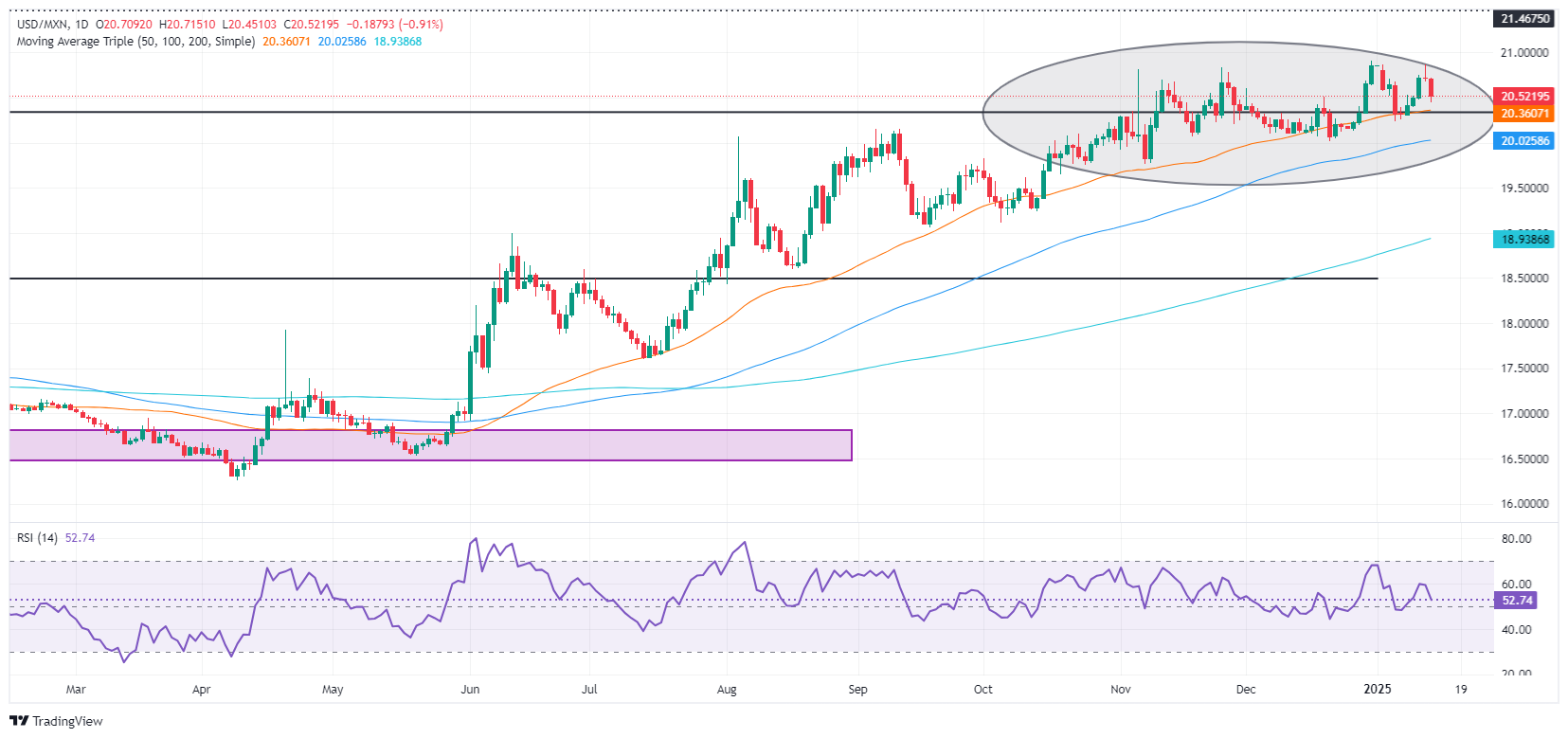Most recent article: Mexican Peso steadies after mixed US CPI report
- Mexican Peso strengthens as December US PPI data suggests easing inflation, lessening Fed pressure.
- Gross Fixed Investment data and President Sheinbaum's nearshoring incentives may further Peso influence.
- US focus on CPI; upcoming retail sales and jobless claims to guide Fed decisions.
The Mexican Peso recovered some ground against the US Dollar on Tuesday after US inflation data suggested that prices paid by producers rose moderately but below economists’ estimates. Although it didn’t change traders' views that the US Federal Reserve (Fed) could lower rates just once in 2025, the Greenback remained on the back foot, a headwind for USD/MXN, which trades at 20.45, down 0.95%.
Mexico’s economic docket remains scarce, but Gross Fixed Investment for October will be released on January 15. Meanwhile, President Claudia Sheinbaum presented a plan to boost nearshoring incentives and reduce the country’s imports from China.
In the US, the December Producer Price Index (PPI) dipped less than estimates, indicating that inflation has resumed its downward trend. Nevertheless, traders are eyeing the release of the latest Consumer Price Index (CPI) for the same period, which is expected to remain around familiar levels.
The US economic schedule will feature the CPI, Fed speakers, Retail Sales data and jobless claims data for the week ending January 11.
Daily digest market movers: Mexican Peso counterattacks ahead of US CPI report
- The Mexican currency advanced on news that the upcoming Trump team is considering gradual tariff hikes of 2% to 5% on a monthly basis.
- Sheinbaum’s “Plan Mexico” would offer incentives for nearshoring, including tax deductions, and develop plans for individual sectors. The decree, which will be published on January 17, offers incentives to domestic and foreign companies.
- Former Deputy Finance Minister Alejandro Werner said in an article by El Economista that the Mexican economy would enter a recession this year and could lose its investment-grade status before 2027.
- The US PPI rose by 3.3% YoY below estimates of 3.4%, up from 3%. Core PPI expanded 3.5% YoY, missed forecasts for a 3.8% increase, up a tenth from 3.4%.
- Last week, Banco de Mexico (Banxico) revealed December's meeting minutes. The minutes showed that inflation continues to trend lower, suggesting that the easing cycle might continue. Banxico's Governing board stated that "larger downward adjustments could be considered in some meetings."
- Kansas City Fed President Jeffrey Schmid said that the Fed will act if Trump’s tariffs throw inflation or jobs off course.
- The Fed's latest Meeting Minutes showed that despite reducing rates, some policymakers supported keeping the fed funds rate unchanged as worries had grown that inflation risks were skewed to the upside.
- Consequently, they adopted a more gradual approach as Fed officials opened the door to slowing the pace of interest rate cuts.
USD/MXN technical outlook: Mexican Peso recovers as USD/MXN falls below 20.50
The USD/MXN uptrend remains in place as long as buyers hold prices above the 50-day Simple Moving Average (SMA) of 20.32, but over the short-term momentum has shifted slightly bearish.
The Relative Strength Index (RSI) is bullish but aims down toward its neutral line, hinting that sellers are stepping in. Therefore, the USD/MXN first support will be the 50-day SMA, followed by the 20.00 figure. On further weakness, the 100-day SMA will be tested at 19.98.
Conversely, if USD/MXN rises past 20.50, the first resistance will be the year-to-date (YTD) peak of 20.90. If surpassed, the next stop would be the March 8, 2022 high of 21.46, ahead of 21.50 and the 22.00 psychological level.
Banxico FAQs
The Bank of Mexico, also known as Banxico, is the country’s central bank. Its mission is to preserve the value of Mexico’s currency, the Mexican Peso (MXN), and to set the monetary policy. To this end, its main objective is to maintain low and stable inflation within target levels – at or close to its target of 3%, the midpoint in a tolerance band of between 2% and 4%.
The main tool of the Banxico to guide monetary policy is by setting interest rates. When inflation is above target, the bank will attempt to tame it by raising rates, making it more expensive for households and businesses to borrow money and thus cooling the economy. Higher interest rates are generally positive for the Mexican Peso (MXN) as they lead to higher yields, making the country a more attractive place for investors. On the contrary, lower interest rates tend to weaken MXN. The rate differential with the USD, or how the Banxico is expected to set interest rates compared with the US Federal Reserve (Fed), is a key factor.
Banxico meets eight times a year, and its monetary policy is greatly influenced by decisions of the US Federal Reserve (Fed). Therefore, the central bank’s decision-making committee usually gathers a week after the Fed. In doing so, Banxico reacts and sometimes anticipates monetary policy measures set by the Federal Reserve. For example, after the Covid-19 pandemic, before the Fed raised rates, Banxico did it first in an attempt to diminish the chances of a substantial depreciation of the Mexican Peso (MXN) and to prevent capital outflows that could destabilize the country.
Information on these pages contains forward-looking statements that involve risks and uncertainties. Markets and instruments profiled on this page are for informational purposes only and should not in any way come across as a recommendation to buy or sell in these assets. You should do your own thorough research before making any investment decisions. FXStreet does not in any way guarantee that this information is free from mistakes, errors, or material misstatements. It also does not guarantee that this information is of a timely nature. Investing in Open Markets involves a great deal of risk, including the loss of all or a portion of your investment, as well as emotional distress. All risks, losses and costs associated with investing, including total loss of principal, are your responsibility. The views and opinions expressed in this article are those of the authors and do not necessarily reflect the official policy or position of FXStreet nor its advertisers. The author will not be held responsible for information that is found at the end of links posted on this page.
If not otherwise explicitly mentioned in the body of the article, at the time of writing, the author has no position in any stock mentioned in this article and no business relationship with any company mentioned. The author has not received compensation for writing this article, other than from FXStreet.
FXStreet and the author do not provide personalized recommendations. The author makes no representations as to the accuracy, completeness, or suitability of this information. FXStreet and the author will not be liable for any errors, omissions or any losses, injuries or damages arising from this information and its display or use. Errors and omissions excepted.
The author and FXStreet are not registered investment advisors and nothing in this article is intended to be investment advice.
Recommended content
Editors’ Picks

AUD/USD drops back to 0.6200 despite strong Chinese data
AUD/USD returns to the red at around 0.6200 early Friday. The Aussie fails to sustain stronger-than-expected China's growth and activity data-led upswing as the RBA's dovish shift and looming Trump's tariff plans remain a drag.

EUR/USD: Trump round two and what it means for EUR/USD
A hawkish Federal Reserve and a dovish European Central Bank put pressure on EUR/USD. US President-elect Donald Trump’s policies set to overshadow macroeconomic releases. EUR/USD set to pierce the year low at 1.0177 and test parity in the upcoming days.

Gold: Weaker US Dollar keeps buyers hungry for the precious metal Premium
The corrective move in Gold remained well in place for yet another week, this time surpassing the $2,720 mark per troy ounce for the first time since mid-December, where an initial resistance zone appears to have emerged.

Week ahead: Markets on edge as Trump’s inauguration and BoJ decision loom
Markets brace for impact ahead of Trump’s inauguration. BoJ seen raising rates at first gathering of 2025. Euro and Pound traders turn gaze to PMIs. Canada and New Zealand CPI data to shape BoC and RBNZ bets. World Economic Forum in Davos also in focus.

Five keys to trading Trump 2.0 with Gold, Stocks and the US Dollar Premium
Donald Trump returns to the White House, which impacts the trading environment. An immediate impact on market reaction functions, tariff talk and regulation will be seen. Tax cuts and the fate of the Federal Reserve will be in the background.

Trusted Broker Reviews for Smarter Trading
VERIFIED Discover in-depth reviews of reliable brokers. Compare features like spreads, leverage, and platforms. Find the perfect fit for your trading style, from CFDs to Forex pairs like EUR/USD and Gold.
